Fanfares, please!
The latest event in the RISC OS Calendar – the RISC OS London Show, 2013 – took place just over three weeks ago in its usual venue, the St Giles Hotel, Feltham. Organised by the RISC OS User Group of London (ROUGOL), the show seemed from my point of view to be as busy and well attended as usual, though I understand the overall number of visitors was down on previous years by a small margin. Having said that, I spoke to a few people who I don’t remember seeing at any shows before – and at least one who confirmed that he was new to RISC OS – so while the numbers may have been down, there do seem to be signs of new interest.
This leads very neatly into a brief discussion that took place the evening before the show when Steve Revill of RISC OS Open Ltd, Neil Fazakerly of Riscy Robots, Bryan Hogan of ROUGOL, and I (of, erm, this site) were the last four people in the hall, having finished doing some setting-up ready for the next day. The subject? How to get people interested in RISC OS. However, the reason the topic came up is because it was to be a key part of Steve’s presentation the following afternoon so I should probably just leave this paragraph, without saying anything more about it, so that it’s nothing more than a teaser for what’s to come later in the report. Oooh!
Instead I shall turn quickly to my trusty coin and flick it to see which way around the show I should head for this report! The result was that I dropped it and it rolled out of sight, so perhaps I shouldn’t go clockwise or anticlockwise, and instead visit stands in a vaguely random order.
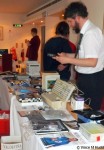
And the first point of interest, then, becomes the charity stand, which was raising money for Combat Stress, the leading charity caring for British veterans suffering as a result of harrowing experiences during their time in the service, with conditions such as Post Traumatic Stress Disorder, severe depression or anxiety. Ian Karley, who was responsible for the stand, informs me that £230 was raised for the charity, with sales being up on last year, adding that quite a few new users wanted things like user guides, which haven’t sold so well in previous years.
At the far end of the hall was the Retro Software stand. Although I said earlier that a brief discussion took place between the last four people around after setting up the evening before, it wasn’t strictly true that we were the last four, because Retro Software had let the organisers know earlier that they expected to be arriving at the venue around midnight to set up, having come straight from another event in Nottingham! It also turned out that they were set to attend yet another event (in London, so not as far) the following day!
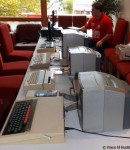
One feature of the Retro Software stand was being able to play relatively new software on old hardware such as the BBC Micro. One example being a game called Mixed Grill March, released in May 2012 and described by the developer as an homage to an arcade game called Muscle March, in which the player’s objective is to chase a thief who has stolen a bodybuilder’s protein powder, matching the thief’s shape as he jumps through various obstacles. In the BBC Micro homage, the player is about to tuck into some pub grub, which is then stolen by Mixed Grill Man when he realises that that the pub has run out – it’s the very last plate of mixed grill!

Speaking of food, sweets could be found on the Orpheus Internet stand, as usual, where Richard Brown was using them to draw in willing punters so that he could tell them about the services offered by the RISC OS-friendly ISP. Originally founded in 2005 by the late Paul Vigay, Orpheus offers a complete range of services, from standard to high-speed fibre-to-the-cabinet broadband packages, and provide full technical support for all the main operating systems – including, of course, RISC OS. The ISP also offers a selection of web hosting packages and other, related services.
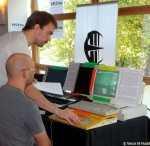
For those with an interest in music creation, 3rd Event Technologies were demonstrating their Archimedes Music Creation System, running on an A3000. Throughout the day, some truly awful noise (sorry Que!) interesting and creative tunes (no, really!) could be heard coming from the direction of their stand.

Trevor Johnson was on hand, trying to recruit visitors into the growing band of people contributing to, and hopefully improving the quality of, the material about RISC OS and anything related that can be found on Wikipedia, under the guise of WikiProject RISC OS.
Trevor also took a little time out from his stand to talk about Wikipedia, and the goals of WikiProject RISC OS in the show theatre – and that talk can be seen on YouTube courtesy of Leo White, who filmed all of the talks:

On the other side of the hall, Nigel Willmott and Martin Avison were keenly demonstrating Organizer, the – no THE – personal information manager for RISC OS, which could be purchased as a download option, or on a memory stick. The latter option, billed as Organizer on a Stick, features the latest version (2.20) of the software loaded onto RPCEmu for operation on Windows PCs, and also includes a zip file containing Organizer for installing on RISC OS computers.
A little further up, Steve Fryatt was talking to visitors about the latest versions of his software such as CashBook, PrintPDF and Locate2. Unfortunately, Steve continues to do a fine job of impersonating me, having not had a chance to do any notable work on any of his software for quite some time.
He did get caught by surprise at the suggestion that he was also billed on the show website as having the latest news on NetSurf developments, which has been the case in the past because he has been involved in working on the browser’s RISC OS front-end. Luckily, however, a cunnng way was discovered to scare away people who wanted to talk about NetSurf: mention the Windows version!
I was next to Steve on the Soft Rock Software stand and, although I had been making good progress on the WebChange manual earlier this year, and was hoping to have it finished by the London show, this was sadly not the case with other things having taken priority, so I was back to explaining to people why it wasn’t yet finished. I could also be grilled on the subject of the new RISC OS Awards website, for which I am currently in the process of deciding the 2012/2013 categories and nominations, and will be putting them online towards the end of November, and a voting form in December.

For those who haven’t quite grown up yet (which, let’s face it, probably includes rather a lot of us) Leo White – who also filmed the theatre talks and uploaded them to YouTube (as embedded in this report) had brought along a couple of his Raspberry Pi-controlled BigTraks.
Also on his table was a Raspberry Pi with a Pimoroni PiGlow LED add-on board installed. The board uses an SN3218 8-bit 18 channel PWM chip to drive 18 surface mounted LEDs, arranged in a spiral pattern, each of which can be individually controlled – in this case from RISC OS.
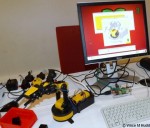
Next door to Leo, Neil Fazakerley had an array of robot arms on the Riscy Robots stand, all controlled by a simple interface written in BBC BASIC, in which a diagram of the arm is displayed in a window, and the user clicks on a particular directional control to make the relevant part of the arm move in that direction (including outwards and inwards to open and close the claw). Each “joint” of the arm features two basic directional controls, and that joint (and therefore the controls) are highlighted as the mouse pointer is moved over that part of the diagram.
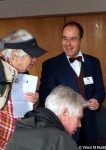
MW Software‘s Martin Wuerthner, missing from the Midlands and Portsmouth shows, had the newest version of Easi/TechWriter with him – version 9.12 – which was completed around the end of September. New features in 9.1 include improved MS Word (.docx) import, coping with headers and footers, cropped images, subscript and superscript, and so on. The software can now also export HTML4 with CSS, providing better separation of content and style, and a much closer representation of document styles in the resulting files.
Next to Martin, Christopher Dewhurst was extolling the virtues of on-off-on-off-under new management magazine, Drag ‘n Drop, which he took over from original editor Paul Stewart a little over a year ago. The most recent issue of the magazine, published quarterly in PDF format, was the Autumn issue and came out earlier this month, so the next issue can be expected in two or three months time.

Moving from PDF to print, Jim Nagel had brought along the hot-off-the-press latest issue of Archive Magazine, volume 23, number 7. Features in this issue include reports of the Wakefield and Portsmouth shows, an article about using PhotoDesk on a Raspberry Pi to produce a greetings card, two pieces – supplied entirely independently – covering JPEG compression, and much more. For those unable to attend and collect their copies at the show, they should be posted out this week (and will have already arrived by the time I finish writing this show report!)
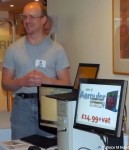
Next to Jim, Adrian Lees was demonstrating Aemulor, a piece of software that was originally developed for the Iyonix to help bridge the gap between the 32-bit hardware, and all the old 26-bit software people would want to run on it. Modern versions of Aemulor allow that same older, 26-bit software to run on modern boards such as the Raspberry Pi.

Elsewhere, the majority of stands were put to shame by Michael Emerton, with a professional display stand with four systems running his RiscDJ software silently, along with a fifth that was providing audio.
The software is a digital music library solution that can support hundreds of thousands of MP3 and OGG tracks and, although it currently runs full screen, the presentation is an extremely slick ‘neon’ look – though it is designed to support skinning, allowing users to come up with a whole new look if they choose.
RiscDJ is written in BBC Basic, using Basalt – and that was being demonstrated on the stand next door by its developer, Steve Drain. Basalt is short for BASIC Alternative keywords, and is Steve’s module that extends BBC BASIC V, as found on all RISC OS computers, by providing additional keywords and features.

Along with Basalt, Steve unsurprisingly brought along his Raspberry Pips, a couple of Raspberry Pis that have been modified to fit in a much flatter case – about the size of a typical modern smartphone – than they normally would, making them look much neater when used with a Lapdock, Motorola’s netbook-style keyboard and screen solution for some of their mobile phones.
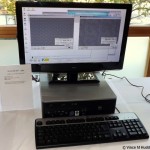
RPCEmu, the cross-platform RiscPC and A7000 emulator, was being demonstrated by Matthew and Peter Howkins, who were running the software on a couple of PCs, one from 2005 and one from 2009. Interestingly, the 2009 machine – a Hewlett Packard dc7900 SFF, running Windows 7 on an Intel Core 2 3.00GHz processor with 4GB RAM – was running two copies of RPCEmu side by side, one with RISC OS 4.02, and one with RISC OS 5.21.
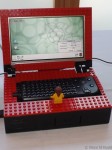
Also on the RPCEmu stand was a Rasperry Pi-book, a Rasperry Pi in a netbook-style case, made from “fine grade Danish plastic” – that’s Lego to me and you – with an 800×480 HDMI monitor, and appropriately sized USB keyboard, etc.

Immediately next to one of the two machines running RPCEmu, standing proud with its bright yellow front panel was the machine that never was: Acorn’s RiscPC replacement, the Phoebe 2100. The computer, on loan from the Centre for Computing History, is one of only two prototype machines ever made, and is believed to be the only one of the two that is still working.
The machine was designed with a 233MHz StrongARM processor, although there would be significant speed gains over StrongARM-equipped RiscPCs due to a better memory architecture, as well as a new version of the VIDC20 video chip, supporting more video memory and providing better performance. The machine was also designed with four PCI expansion slots to open up the possibity of using industry standard expansion cards. All this for a “mere” (ahem) £1,760 – without a monitor.
Some of you may remember a request put out by CJE Micro’s earlier this year, asking for one or more people who would be willing to help update the RISC OS Welcome Guide. Bernard Boase responded to that request and, once he started looking at it, concluded that something a little more was needed than Chris originally asked for, especially with the number of people who could potentially try RISC OS thanks to the Raspberry Pi and NOOBS, who would be coming from different platforms with different ways of doing things. Bernard is therefore now working towards something more comprehensive, up-to-date and, hopefully, well presented and easily digestible – and, above all, easily accessed – and needs volunteers to help with the task, to assist with both writing and proof-reading.

And speaking of CJE Micro’s, who reading this would be surprised to hear they were present at the show, having brought along a huge amount of stock? Because, yes, as usual, Chris Evans and Andrew Conroy were at the show, with a wide range of hardware and software, catering for just about every need.
Disappointingly, Andrew hasn’t written a 3-dimensional Breakout game for his LED Cube, previously displayed at the Portsmouth show on the Southampton Acorn User Group stand, but which he didn’t bring along to this show.
Chris also gave one of the day’s theatre presentations, in which he talked about a wide range of products, such as battery and clock solutions for the RiscPC, the In-a-Box solutions for the Raspberry Pi and PandaBoard, and much more.
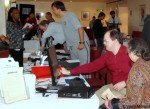
R-Comp, of course, also had a large presence, with the usual wide array of machines set up on their stand and running RISC OS, both native and emulated. Perhaps the biggest news from Andrew and the team was the release of version 1.00 of the Store app, which tends to be referred to as PlingStore – in this case, the exclamation mark (or ‘pling’ in RISC OS circles) is pronounced as part of the application’s name – which means it matches the name of the corresponding website.
Version 1.00 of the software brings with it the ability to purchase commercial applications, and allows users to set up an account in which their purchase and download histories are stored so that, should they move to a new computer (for example), they can easily access the software they obtained via the system previously to install it again. PlingStore is supplied with all new RISC OS distributions from R-Comp, as well as on the SD cards supplied by RISC OS Open for the Raspberry Pi, but for those still clinging onto older computers it is, of course, a free download. PlingStore, unsurprisingly, formed a large part of Andrew’s theatre presentation:
First shown to a surprised public at the South West show earlier this year, ImpressionX was again being demonstrated by Richard Keefe, who has taken over development of a 32-bit version of Impression Publisher from X-Ample Technology as of May 2012. While there is an awful lot of work ahead of Richard to make the software 32-bit, he does intend to release some modules, perhaps within the next six months, such as new versions of the graphics loaders, which will be compatible with older versions, as well as the 32-bit version when it is eventually complete.

And last but not least, RISC OS Open Ltd were there to answer any questions people had about the latest developments to the operating system, and were selling the latest versions of the SD Cards for the Raspberry Pi – the Nut Pi cards, featuring a wealth of software, as well as the cards containing the RISC OS disc image for booting the system, along with their various USB sticks (Native, Emulate, Develop) etc.
RISC OS Open’s Ben Avison was also showing off his latest release under the banner of Piccolo Systems – SystemDisc, the latest member of the DiscTools family. The software is able to take any size of SD card and initialise it as a bootable card, so that the full capacity of the card can be used by RISC OS – and not just for Raspberry Pi users; SystemDisc can create bootable SD cards for BeagleBoard and PandaBoard systems as well.
In his theatre presentation, RISC OS Open’s Steve Revill touched on such matters as why a version of RISC OS 5 had been released for legacy hardware, and talked about the need for up-to-date documentation, bringing in Bernard Boase as a guest speaker to talk about his efforts on updating the user guide.
From there, Steve worked around to what he described as the ‘core’ of what he wanted to talk about, which is what was briefly discussed the evening before the show – how to get people interested in and using the operating system. Steve suggested that if there are any interesting projects being carried out with RISC OS behind them, they need to be brought to the public’s attention – and if anyone can think of something that could be done with RISC OS, and which would attract interest, that idea needs to be put forward and discussed, perhaps on the ROOL forums, which could lead to someone taking up the idea and running with it.
So that was the London Show, 2013. Did you miss it? Shame on you!




